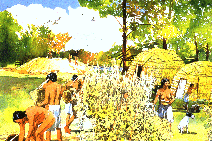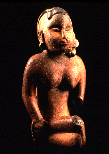| Environment | Technology | Settlement | Economy | Society | Health | Religion | |
| How-Do-We-Know? | |||||||
| Paleo-Indian | Archaic | Woodland | Mississippian | European Contact |


Like their forebearers, Woodland groups were largely classless and egalitarian with most differences in status and work being drawn along lines of sex, marriage, and age. By the middle of the period, however, there is evidence of developing status differences among community members. High ranking individuals were buried in circular or cone-shaped mounds constructed from basket loads of earth. The most important people were sometimes laid to rest on floors of log tombs surrounded by earthen ramps. Some of these mound burials included funerary objects made of non-local materials such as obsidian, alligator teeth, and marine shells. Exactly how these far flung exchanges networks throughout the Eastern United States functioned is unclear. Like other horticultural societies of the world, however, it is likely that differences in status and rank developed along lines of kinship.
Post-supported structures of previous periods were clearly all residential and exhibited little difference in size, or shape. Some Woodland buildings, however, were larger or shaped differently, suggesting they were intended not for residences but for religious or community use. Specialized structures strongly imply that some community members may have had additional social or religious responsibilities, functions, and status.
| Paleo-Indian | Archaic | Woodland | Mississippian | European Contact |